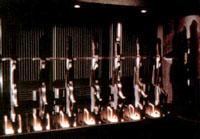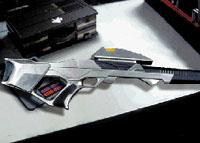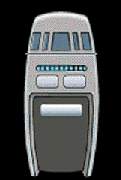|
|
|
 Located on
deck 5- Top Saucer Module, the security section of the Agamemnon is the
primary operations center for coordinating security activities and related
functions aboard the ship. The section is composed of several offices
as well as storage areas. In addition, the first of two main armories
onboard is located there. Typically stored under lock in the armories are
heavier assault weapons, explosive devices, and other dangerous weapons.
Type III phaser rifles are often stored here.
Located on
deck 5- Top Saucer Module, the security section of the Agamemnon is the
primary operations center for coordinating security activities and related
functions aboard the ship. The section is composed of several offices
as well as storage areas. In addition, the first of two main armories
onboard is located there. Typically stored under lock in the armories are
heavier assault weapons, explosive devices, and other dangerous weapons.
Type III phaser rifles are often stored here.
 In addition
to weapon storage, the security section contains a brig area. Composed
of smaller individual cells, the brig is designed to hold occupants in
a safe and confined area. Each brig is protected by powerful
forcefields, preventing escape of any person(s) inside. Working in
conjunction with the forcefields are complex dampening fields which prevent
the occupant from beaming out via transporter, or communicating with any
outside forces.
In addition
to weapon storage, the security section contains a brig area. Composed
of smaller individual cells, the brig is designed to hold occupants in
a safe and confined area. Each brig is protected by powerful
forcefields, preventing escape of any person(s) inside. Working in
conjunction with the forcefields are complex dampening fields which prevent
the occupant from beaming out via transporter, or communicating with any
outside forces.
Weaponry for security personnel and landing party use is stored within a locked, phaser resistant chambers. All armory bulkheads are lined with a layer of abalative armor.
Access to each of the weapons storage chambers is furnished via a reinforced door on one wall of the armory foyer. The clearance desk outside the door is manned at all times by two security officers behind a protective forcefield, whose duty it is to check in and out all weaponry. Palmprint and DNA scan insures that no unauthorized personnel check out equipment at any time.
The main armory has a repair department for damaged weapons and a analysis area for studying new alien weapons or if any technical problems should arise.
A wide range of weapons types and sizes are stored within the armory chambers. Phasers Type I, II, and III stored in quantity, as are the newer Compression Phaser Rifles. Anti-Matter mortars, Stun Grenades, Concussion Grenades, Timed Explosives, Phaser Power Packs, Molecular Binders, Utility Belts, Photon Cannons and Portable Forcefield Projectors. Enough hand phasers, stored in racks, are contained here to arm the entire crew, if necessary. Security armor hangs against one wall.
The chamber door is unlocked by punching a preset code into a panel
beside the door. The security code is changed at the beginning of
every duty shift, and is known only to the shipís Captain, First
Officer, Chief of Engineering and Security Chief, and to those security
agents guarding the room.
Light Stun
Setting 1: Damage Index: 0. This setting is calibrated for humanoid
physiology, and causes temporary central nervous system (CNS) impairment.
It can rendered a subject unconscious for 5 minutes. Repeated long exposures
can cause CNS damage.
Medium Stun
Setting 2: Damage Index: 0. Base-type humanoids are rendered
unconscious for up to fifteen minutes, resistant humanoids up to five minutes.
Long exposures produce low levels of irreversible CNS and epithelial damage.
Heavy Stun
Setting 3: Damage Index: 1. Base humanoids remain in a sleep
state for approximately one hour,
resistant bioforms for fifteen minutes. Repeated exposures can
cause servere irreversible CNS and
epithelial damage.
Thermal Effects
Setting 4: Damage Index: 3.5. Base humanoids experience extensive
CNS damage and epidermal EM trauma. Structural materials exhibit
visible thermal shock. Discharges of longer than five seconds produce
deep heat storage effects within metals.
Setting 5: Damage Index: 7. Humanoid tissue experiences serve
burn effects but, due to water content, deep layers will not char.
Simple personnel forcefields are penetrated after five seconds.
Disruption Effects
Setting 6: Damage Index: 15. Organic tissues and light structural materials
exhibit comparable
penetration and molecular damage effects are higher energies cause
matter to dissociate rapidly.
Setting 7: Damage Index: 50. Organic tissue damage is lethal
at this power setting.
Setting 8: Damage Index: 120. Humanoid organisms are vaporized
instantly.
Setting 9: Damage Index: 300. Medium alloy or ceramic structural
material over 100 cm thick is
vaporized after .50 seconds.
Setting 10: Damage Index: 450. Heavy alloy structural materials
over 100 cm thick is vaporized after .55 seconds.
Explosive/Disruption Effects
Setting 11: Damage Index: 670. Ultradense alloys structural materials
over 100 cm thick is vaporized in .20 seconds.
Setting 12: Damage Index: 940. Ultradense alloys structural materials
over 100 cm thick is vaporized in .10 seconds.
Setting 13: Damage Index: 1100. Shielded matter exhibits minor
vibration heating affects.
Setting 14: Damage Index: 1430. Shielded matter exhibits
medium vibration heating affects.
Setting 15:Damage Index: 1850. Shielded matter exhibits major
vibration heating affects.
Setting 16: Damage Index: 2450. Shielded matter exhibits light
mechanical fracturing damage.
 This small,
hand-held, easily concealed side arm combines the latest in microcircuitry
and energy flow alignment techniques. Indeed, the new Type
I boast a maximum power output three times that of the first old model.
Characterized by its wafer-thin styling, the Type I Phaser is less than
10 centimeters long and 2.5 centimeters wide. Inside this slim housing
are two power converter chips that can be recharged from a portable energy
packs or from an adaptable connector on standard tricorders. Unique
to this design is the hand-print security coding, which makes each
weapon responsive only to a single set of fingerprints. This surface
plate of Type I Phaser contains two pressure-sensitive energy regulators:
the left-hand activator controls non-lethal energy discharges and the right-hand
plate deals with more destructive energies. In normal use, the user
selects the amount of energy to be released from the appropriate activator
by the amount of finger pressure on the proper plate, thus eliminating
the need to adjust settings at a critical moment.
This small,
hand-held, easily concealed side arm combines the latest in microcircuitry
and energy flow alignment techniques. Indeed, the new Type
I boast a maximum power output three times that of the first old model.
Characterized by its wafer-thin styling, the Type I Phaser is less than
10 centimeters long and 2.5 centimeters wide. Inside this slim housing
are two power converter chips that can be recharged from a portable energy
packs or from an adaptable connector on standard tricorders. Unique
to this design is the hand-print security coding, which makes each
weapon responsive only to a single set of fingerprints. This surface
plate of Type I Phaser contains two pressure-sensitive energy regulators:
the left-hand activator controls non-lethal energy discharges and the right-hand
plate deals with more destructive energies. In normal use, the user
selects the amount of energy to be released from the appropriate activator
by the amount of finger pressure on the proper plate, thus eliminating
the need to adjust settings at a critical moment.
 When shipís personnel
are expecting danger or need a show of force, the heavier Type II Hand
Phaser is an appropriate weapon. With its broom-handle design, this
slender and light weapon is usually worn in a velcro hip-holster that doubles
as a recharging unit. The Type II combines two interlocking phased-particle
beams in collimator field to produce a single-charged particle beam.
The resulting firepower is far greater than earlier models, and is capable
of penetrating the strongest alloy or reflective defensive armor at close
range. By altering the frequency of the beamís dispersal pattern,
the Type II power collimator can also reduce the electron flow, generating
a simple laser or a variety of plasma like beams suitable for non-combat
emergencies when communications or energy transmission are required.
As with other phaser designs, the Type II offers a variety of lethal and
non-lethal settings.
When shipís personnel
are expecting danger or need a show of force, the heavier Type II Hand
Phaser is an appropriate weapon. With its broom-handle design, this
slender and light weapon is usually worn in a velcro hip-holster that doubles
as a recharging unit. The Type II combines two interlocking phased-particle
beams in collimator field to produce a single-charged particle beam.
The resulting firepower is far greater than earlier models, and is capable
of penetrating the strongest alloy or reflective defensive armor at close
range. By altering the frequency of the beamís dispersal pattern,
the Type II power collimator can also reduce the electron flow, generating
a simple laser or a variety of plasma like beams suitable for non-combat
emergencies when communications or energy transmission are required.
As with other phaser designs, the Type II offers a variety of lethal and
non-lethal settings.
There is four current versions of the Compression rifle.
Version A:
 This model
of phaser aboard the USS Voyager NCC-74656. It fires a yellow beam,
and is used more frequently than the preceding models.
This model
of phaser aboard the USS Voyager NCC-74656. It fires a yellow beam,
and is used more frequently than the preceding models.
Version B:
 Although
they all function in the same way,there are several models of phaser rifle
available in the 2370ís. This model features a double-handed grip
that is similar to that of its immediate predecessor.
Although
they all function in the same way,there are several models of phaser rifle
available in the 2370ís. This model features a double-handed grip
that is similar to that of its immediate predecessor.
Version C:
 Type C is
constructed of light weight material and can be carried in one hand.
Some models, such as this one, have a single grip. For accuracy in aiming,
the user can support the barrel with his or her free hand without danger.
Type C is
constructed of light weight material and can be carried in one hand.
Some models, such as this one, have a single grip. For accuracy in aiming,
the user can support the barrel with his or her free hand without danger.
Version D:
 After Starfleetís initial
encounters with the Borg it becomes clear that in order to prove effective
against all species the phaser will have to be adjusted. All models
of phaser rifle in use in 2373 can be programmed to automatically alter
the frequency of the beam,
After Starfleetís initial
encounters with the Borg it becomes clear that in order to prove effective
against all species the phaser will have to be adjusted. All models
of phaser rifle in use in 2373 can be programmed to automatically alter
the frequency of the beam,
making it harder for an opponent to generate effective shields.